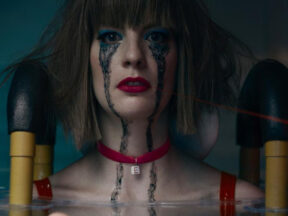

2024 Oscars Short Film Contenders: ‘Humo’ Director Rita Basulto
Welcome to Cartoon Brew’s series of spotlights focusing on the animated shorts that have qualified for the 2024 Oscars. There are several ways a film can earn eligibility. With these profiles, we’ll be focusing on films that have done so by winning an Oscar-qualifying award at an Oscar-qualifying festival.
Today’s short is Humo from four-time Mexican Academy Ariel Award-winner Rita Basulto. Humo earned its Oscars qualification by winning best animated short award at HollyShorts.
Animated in stop motion, Humo is the first-person account of a small boy living in a Nazi concentration camp. As carefully detailed, gaunt puppets slowly move through the camp, the protagonist describes his life with a heartbreaking innocence and naivety.
Cartoon Brew: This short is an adapted from a short story, how was the writing process handeled?
Rita Basulto: The film is an adaptation of the illustrated children’s book Humo by Antón Fortes. We secured the rights to the story through the Spanish publishing house OQO, and Juan Medina, who also serves as producer on the film, wrote the script adaptation for it. Over the years, we have made several short films inspired by children’s books from OQO. The scripts are adaptations of beautifully illustrated children’s stories. Among them, I discovered Humo, illustrated by Joanna Concejo. It’s a powerful and moving story, and I will always remember how the poetry of its intense images moved me to tears.
What was it about this story or concept that connected with you and compelled you to direct the film?
What drew me to this story the most was that it is told from the point of view of its anonymous little protagonist, defenseless against the horrors of war. This showed a brutal contrast between dehumanization and innocence, thus achieving one of the deepest and most forceful voices in human consciousness, leaving us with a heartbreaking, endless echo in our souls to this day. The innocent do not survive, said Primo Levi; it is the price for seeing the light.
What did you learn through the experience of making this film, either production-wise, filmmaking-wise, creatively, or about the subject matter?
With this film, I learned that beyond the limitations of financial resources, we should never give up and stop making our projects. No matter how long it takes us, quality cannot be sacrificed just to meet institutional deadlines. I also learned that technology is a great ally that can help reduce production times and raise the quality of our films, which is why young filmmakers have a great advantage in these times. Technology removes any excuse for not producing and following through with their projects.
Can you describe how you developed your visual approach to the film? Why did you settle on this style/technique?
I did endless research and was very moved by the photographic records of this period. I was faced with a story that required many locations and countless extras, so I had to sit with it for a bit before arriving at the design you see on screen. I decided to go down the path of resource austerity and adopted the mantra of ‘less is more.’ I wanted to use a few elements that were loaded with symbolism. For example, using lines as a symbol of the loss of freedom. There are lines everywhere in the short: the bars on their uniforms, the barbed wire, the columns and beams of the barracks and bunk beds, and even the expression lines of the characters and the cardboard extras were also thought out in this manner. Our story unfolds in an imperfect world where asymmetry and disproportion reign, from the characters’ bodies and faces to the smallest details in the set design.



